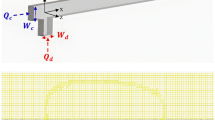Abstract
Here we aimed to investigate various droplet formation regimes in a two-dimensional T-junction microchannel geometry using the open source software OpenFOAM. Two incompressible fluids, continuous phase in the main channel and dispersed phase in the lateral channel, have been considered. The interFoam solver was used to simulate laminar flow with two incompressible and isothermal phases. We evaluated the capability of “Compressive Interface Capturing Scheme for Arbitrary Meshes (CICSAM)” volume of fluid (VOF) technique of the OpenFOAM for modeling of the droplet formation and movement in different regimes. The flow behavior in the T-junction microchannel over a wide range of capillary numbers (0.006 to 0.12), volume flow rate ratio (0.125, 0.25, 0.5), and contact angle (130° to 180°) in the squeezing, dripping and jetting regimes were examined.The importance of parameters such as contact angle, capillary number, flow rate ratio, and Reynolds number at the time of separation, as well as the formation of droplets, was investigated in different regimes. We found that droplet detachment time increases by increasing the contact angle in the squeezing regime while increasing the contact angle in the dripping regime results in a decrease in the droplet detachment time. We compare the role of pressure gradient and shear stress forces in the droplet formation process in both dripping and squeezing regimes in details. We also provide a classification of two-phase flow regimes in the investigated T-junction microchannel in terms of three main parameters of, e.g., flow rate ratio, contact angle, and capillary number.













Similar content being viewed by others
References
Arias, S., Legendre, D., González-Cinca, R.: Numerical simulation of bubble generation in a T-junction. Comput. Fluids 56, 49–60 (2012)
Berberovic, E.E.: Investigation of free-surface flow associated with drop impact: numerical simulations and theoretical modeling. PhD diss. TU Darmstadt/FG Strömungslehre und Aerodynamik (2010)
Deshpande, Suraj S., Anumolu, L., Trujillo, M.F.: Evaluating the performance of the two-phase flow solver interFoam. Comput. Sci. Discov. 5(1), 014016 (2012)
Galusinski, C., Vigneaux, P.: On stability condition for bifluid flows with surface tension: Application to microfluidics. J. Comput. Phys. 227(12), 6140–6164 (2008)
Galbiati, L., Andreini, P.: Flow pattern transition for horizontal air-water flow in capillary tubes. A microgravity “Equivalent system” simulation. Int. Commun. Heat Mass Trans. 21(4), 461–468 (1994)
Gupta, A., Murshed, S.S., Ranganathan K.: Droplet formation and stability of flows in a microfluidic T-junction. Appl. Phys. Lett. 94(16), 164107 (2009)
Guo, F., Chen, B.: Numerical study on Taylor bubble formation in a micro-channel T-junction using VOF method. Microgravity Sci. Technol. 21(1), 51–58 (2009)
Hoang, D.A., Portela, L.M., Kleijn, C.R., Kreutzer, M.T., Van Steijn, V.: Dynamics of droplet breakup in a T-junction. J. Fluid Mech. 717, R4 (2013)
Jang, J., Wereley, S.T.: Pressure distributions of gaseous slip flow in straight and uniform rectangular microchannels. Microfluid. Nanofluid. 1(1), 41–51 (2004)
Klostermann, J., Schaake, K.S.: Numerical simulation of a single rising bubble by VOF with surface compression. Int. J. Numer. Methods Fluids 71(8), 960–982 (2013)
Konishi, C., Mudawar, I.: Review of flow boiling and critical heat flux in microgravity. Int. J. Heat Mass Trans. 80, 469–493 (2015)
Niazmand, H., Renksizbulut, M., Saeedi, E.: Developing slip-flow and heat transfer in trapezoidal microchannels. Int. J. Heat Mass Trans. 51(25), 6126–6135 (2008)
Rajesh, V.M., Vivek, V.B.: Experimental characterization of gas–liquid–liquid flows in T-junction microchannels. Chem. Eng. J. 207, 832–844 (2012)
Roohi, E., Zahiri, A.P., Passandideh-fard, M.: Numerical simulation of cavitation around a two-dimensional hydrofoil using VOF method and LES turbulence model. Appl. Math. Modell. 37(9), 6469–6488 (2013)
Santos, R., Kawaji, M.: Effect of contact angle on gas slug formation, shape and flow in a microchannel T-junction by numerical simulation. In: 19th International Congress of Chemical and Process Engineering (2010)
Ubbink, O.O.: Numerical prediction of two fluid systems with sharp interfaces. PhD Dissertation University of London (1997)
Wang, L.L., Li, G.J., Tian, H., Ye, Y.H.: Simulations of droplet formation in a t-junction micro-channel using the phase field method. Int. J. Comput. Methods 04, 11 (2014)
Weller, H.G.: A new approach to VOF-based interface capturing methods for incompressible and compressible flow, Technical Report TR/HGW/04, OpenCFD Ltd. (2008)
Xu, J., Li, S., Tan, J., Luo, G.: Correlations of droplet formation in T-junction microfluidic devices: from squeezing to dripping. Microfluid. Nanofluid. 5(6), 711–717 (2008)
Yan, Y., Guo, D., Wen, S.Z.: Numerical simulation of junction point pressure during droplet formation in a microfluidic T-junction. Chem. Eng. Sci. 84, 591–601 (2012)
Youngs, D.L.: Time-dependent multi-material flow with large fluid distortion. Numer. Methods Fluid Dyn. 24, 273–285 (1982)
Author information
Authors and Affiliations
Corresponding author
Rights and permissions
About this article
Cite this article
Malekzadeh, S., Roohi, E. Investigation of Different Droplet Formation Regimes in a T-junction Microchannel Using the VOF Technique in OpenFOAM. Microgravity Sci. Technol. 27, 231–243 (2015). https://doi.org/10.1007/s12217-015-9440-2
Received:
Accepted:
Published:
Issue Date:
DOI: https://doi.org/10.1007/s12217-015-9440-2




